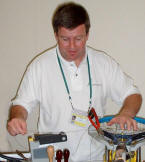|
|
  STRINGS STRINGS
Liam Nolan, one of the UK's top stringers, tells us
about one of the most important parts of your game - if only
most of us knew it .... |
|
How do racket strings perform, why
do they break
and how often they should be replaced ???
Some
string facts;
-
 Squash strings are made of natural
gut, nylon or aramid
fibre. Squash strings are made of natural
gut, nylon or aramid
fibre.
-
Strings are always losing tension because the inner
molecules are continually moving apart and this “Creep”
continues until it breaks.
-
Strings break for two reasons – when they rub against
each other and wear away until one of them gets too thin
and breaks, or when the string cannot stretch enough on
ball impact, usually near the edge of the racket.
-
Strings work by absorbing the incoming ball impact and
then sending it back with
as much velocity as possible. The more elastic the
string, the more speed on the return journey.
-
Thinner strings will be more elastic, will break
quicker, thicker strings will be generally more durable
but less able to return the ball fast.
|
Liam Nolan
Technical Director,
UK
Racket Stringers Association,
Master Racket Technician USRSA
liam@ukrsa.com
www.ukrsa.com
+44 (0)7861
380981







 |
|
String Materials
Natural Gut – At
one time the ONLY string about and rarely used these days
due to its high cost and short life. It comes from the cow
and goes through a long laborious process (hence the
expense) where it is cut, stretched, dried, twisted,
polished and finally given a polyurethane coating to protect
it from harmful moisture that swells the fibres and unravels
everything.
Some professionals like natural gut because it
performs best of all until the moment it breaks, because the
ongoing “creep” effect is almost nil and the shots will
retain their accuracy.
 Nylon
–Accounts
for about 99% of all strings, is not affected by water, is
not too expensive and comes in either a “multifilament” that
copies natural gut or a “solid core” nylon that will perform
well until it breaks. Nylon
–Accounts
for about 99% of all strings, is not affected by water, is
not too expensive and comes in either a “multifilament” that
copies natural gut or a “solid core” nylon that will perform
well until it breaks.
Many professionals use this cheaper
solid core nylon a lot as they will restring often anyway
due to the “creep” effect causing them to lose control.
Nylon is a material that bonds onto other nylons very well,
so it is easy to blend together various combinations of
elastic fibres and durable wear layers to give different
playing experiences.
There have been some exciting new
strings come onto the market which offer high playability
with good durability. The thinner gauge strings such as
Tecnifibre X-One and Ashaway’s Powernick18 are good examples
of either very good playability with good durability or good
playability with very good durability.
What you gain with
one string, you tend to lose something else. Each will have
their own following because they suit different types of
play.
Polyester –
Designed for tennis players who break strings each week,
either because they hit the ball so hard, maybe with heavy
topspin or because they play on clay courts where the clay
particles chew up the softer nylon.
Durability is the
advantage and no polyester has yet been developed that will
allow a reasonable amount of playability for the much
lighter squash ball.
Aramid Fibre –
Usually called Kevlar, an ultra strong string that is used
for body armour, not good for the arm and is rarely seen.
Fischer have used this string for the central six mains in
some rackets.
|
|
String
Tensions
 Think of yourself jumping up and down
on a trampoline. In the middle, where the bed is softer,
your feet sink in deep into the trampoline bed and you can
get really good height but no real confidence of where you
are heading! Think of yourself jumping up and down
on a trampoline. In the middle, where the bed is softer,
your feet sink in deep into the trampoline bed and you can
get really good height but no real confidence of where you
are heading!
If you stray out towards the edge of the
trampoline bed you end up with little bounces as the bed is
stiffer, cannot get so much height but feel more in control.
This is exactly what happens on a racket stringbed. A low
tension will allow the ball to sink in deep, create POWER
and propel it a long way. High tension means more CONTROL
over the flight of the ball.
This is because the ball spends
less time on the strings (ball dwell) before leaving.
|
 So what to choose? So what to choose?
Experiment with
various solid core and multifilament nylon strings, keeping
the tension mid range, around 28lbs.
Never wait months for
strings to break as by the time they do expire, they have
long lost their original performance.
 |
|
|
|